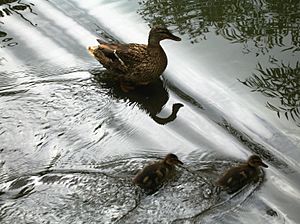Superposition principle facts for kids
In physics, the superposition principle is a cool idea that helps us understand how different things combine. It says that if you have two or more separate "actions" happening at the same time in the same place, the total result is just what you get when you add up the results of each action by itself.
This idea works best for special kinds of systems called linear systems. Many things in the world, from sound waves to electric currents, can be thought of as linear systems. Because of this, the superposition principle is super useful in many areas of physics and engineering.
Contents
What is the Superposition Principle?
The superposition principle is like mixing different colors of paint. If you mix blue and yellow, you get green. The green is the "superposition" of blue and yellow. In physics, it means if you have two forces pushing on an object, the object moves as if both forces were pushing it at the same time.
How Does it Work?
Imagine you have a toy boat in a bathtub.
- If you make a wave by tapping the water on one side, the boat bobs up and down.
- If you make another wave by tapping on the other side, the boat bobs up and down differently.
- Now, if you tap both sides at the same time, the boat's movement will be the combination of both bobs. It's like adding the two separate movements together.
This "adding together" is what superposition is all about.
What are Linear Systems?
The superposition principle works perfectly for "linear systems." Think of a linear system as something where the output is directly proportional to the input.
- If you push twice as hard, it moves twice as far.
- If you have two pushes, the total movement is just the sum of the movements from each push.
Many things in physics are linear, at least for small changes. For example:
- Small waves on water.
- Sound waves traveling through air.
- Electric currents in simple circuits.
Examples of Superposition
- Waves: When two waves meet, like ripples in a pond or sound waves from two speakers, they combine. The high parts (crests) and low parts (troughs) of the waves add up. This can make the waves bigger (constructive interference) or cancel each other out (destructive interference).
- Forces: If you and a friend both push a box, the total force on the box is the sum of your individual pushes. The box will move as if one person pushed it with that combined force.
- Electricity: In an electric circuit, if you have several power sources, the total current or voltage at any point can be found by adding up the effects of each power source acting alone.
Images for kids
See also
 In Spanish: Principio de superposición para niños
In Spanish: Principio de superposición para niños



